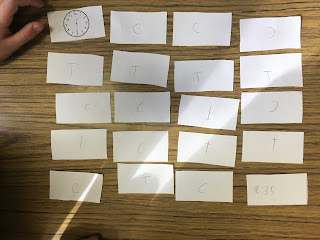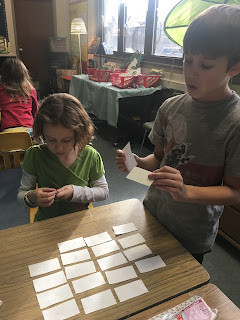Another game that has become a fast favorite in Math is "Beat the Calculator". The children play three roles: the "caller", the "brain" and the "calculator". The caller calls out addition problems, the brain solves the problem in their head and the calculator must solve the problem only using the calculator. It was great to see how often the brain solved the problem fast than the calculator!
Friday, January 27, 2017
Telling Time
This week the students learned to play a math game called ""Clock Concentration" which works much like the game of memory, except that instead of an exact picture match, analog times are matched with digital times. Practicing time on an analog clock (or watch) at home is a great way to improve your child's skills!


Paragraph Writing
Over the past few weeks we have been working on paragraph writing, including elements of topic sentence, supporting details, and closing sentence. The students have learned to use two very similar graphic organizers for planning their paragraph. The umbrella is one they draw themselves in their notebook, and the Empower Brain Frame is one that is ready for them to fill out. (Mostly it's personal preference and nice for them to have a choice.) The children are learning to write persuasive / opinion based writing, as well as factual / nonfiction writing. For example, the paragraphs below about January are factual. One could also write an opinion based paragraph about why they think January is the best month.
Tuesday, January 17, 2017
Our Environment
This week in Social Studies we began our next unit on the environment, including how people use their environment. We will be learning about natural resources and pollution. This week the children brainstormed all the things we "catch, gather and grow". They decided some things belonged in more than one category, hence the arrows.
Tree Rings
This week in science students learned about tree growth rings. The rings in the tree tell scientists how old a tree is and also gives them some clues about the season conditions for each year it was living. We learned that the dark rings are called "latewood rings" and the light rings are called "earlywood rings". These give scientists some clues about the rain and water for each year of its life. The thicker the earlywood ring, the more rain occurred the summer of that year!
Subscribe to:
Posts (Atom)



























